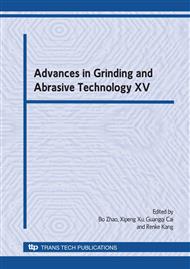p.187
p.192
p.198
p.205
p.210
p.216
p.223
p.228
p.234
Finite Element Simulation of Chip Formation with Single Grain
Abstract:
Three-dimensional cutting process of single grain in the shape of polygonal pyramid was simulated by coupled Euler-Lagrange method. The method makes the workpiece material free from its meshes. The material allowance can be removed without mesh separation criterion. The simulation results show that workpiece material flows to the side and front owing to the pressing of cutting plane. Chip flows out along the front of the grain upward. The deformation of workpiece material contacted with grain edge is very severe. Therefore there is large machining stress concentration at the contact zone of grain edge. It results in biggish residual stress and cutting temperature at the side and bottom of the groove. The contact stress at edge angle of abrasive grain is biggest. Therefore grain wear is severe in the position
Info:
Periodical:
Pages:
210-215
Citation:
Online since:
September 2009
Authors:
Price:
Сopyright:
© 2009 Trans Tech Publications Ltd. All Rights Reserved
Share:
Citation:


